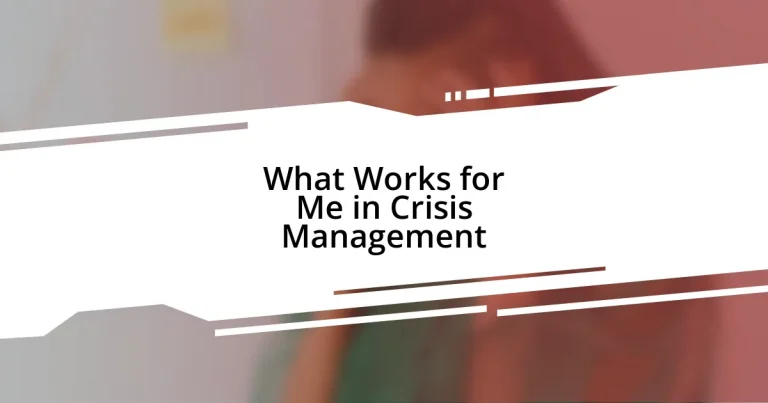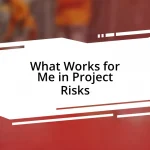Key takeaways:
- Staying calm and focused during a crisis is crucial for effective leadership and team morale.
- Proactive risk assessment and clear communication protocols help anticipate and navigate potential crises.
- Engaging stakeholders with regular updates and personal connections fosters trust and collaboration.
- Post-crisis evaluation and continuous learning are essential for improving response strategies and team resilience.

Understanding Crisis Management Fundamentals
Understanding crisis management fundamentals begins with recognizing that a crisis can strike anyone at any time. I remember a time when a sudden technical failure threatened our entire project timeline. In that moment of panic, it became evident that having a clear plan and key team roles was essential; without these, chaos would have ensued.
It’s crucial to stay calm and focused during a crisis. When I’ve experienced unexpected challenges, I’ve found that taking a step back to assess the situation can be remarkably grounding. This approach not only helps in evaluating the severity of the crisis but also opens the door to collaborating with my team on generating immediate solutions. Have you ever noticed how a calm leader can influence the team’s morale? I’ve seen it firsthand; positivity breeds resilience.
Lastly, communication is the linchpin of effective crisis management. Sharing information transparently with my team builds trust and fosters a supportive environment, allowing for quick and informed decision-making. I recall a project mishap where I chose to keep communication lines open, which ultimately led to a collaborative effort in problem-solving, easing tensions. How do you see communication playing out in your own experiences during crises? It’s a powerful tool that can transform potential chaos into a united front.

Identifying Potential Crisis Scenarios
Recognizing potential crisis scenarios often begins with a thorough assessment of vulnerabilities. In my own experience, I’ve found that brainstorming potential risks with my team can reveal surprising insights. For example, during one project, we identified that our reliance on a single software platform made us susceptible to outages. Knowing this allowed us to develop a backup plan, which later proved invaluable when the platform experienced significant downtime.
I always suggest reviewing past incidents, too. Reflecting on what went wrong in previous projects can provide a roadmap for identifying trends and anticipating future crises. I recall a particularly stressful situation where our client abruptly changed project requirements. By analyzing this kind of client behavior, I realized we should implement clearer communication protocols from the start. This proactive measure not only fortified our relationship with that client but also equipped my team with strategies to navigate unforeseen demands.
Lastly, I believe considering external factors like market shifts or social trends is essential. Once, our team faced a crisis when a competitor launched a similar product unexpectedly. By keeping an eye on industry news and trends, I could help my team anticipate shifts, allowing us to pivot our strategy quickly. Being attuned to the broader environment can truly make a difference; how does your team stay informed about potential external crises?
| Type of Crisis Scenario | Example from Experience |
|---|---|
| Internal Operational Issues | Technical failure delaying project timelines |
| Client-Related Challenges | Sudden changes in project requirements |
| External Market Shifts | Competitor launching similar product |

Developing a Crisis Response Plan
When developing a crisis response plan, I find that outlining clear strategies and roles is absolutely vital. I once participated in a portfolio review where we outlined various crisis scenarios and assigned specific team members to lead responses. This exercise not only clarified responsibilities but also fostered a sense of ownership, which I believe is crucial during times of uncertainty. Remember, having a designated point of contact allows everyone to stay informed and reduces confusion, which can easily become a secondary crisis.
Here’s a streamlined approach I think can help in crafting an effective response plan:
- Assess Risks: Identify vulnerabilities unique to your organization.
- Define Roles: Assign clear responsibilities to team members.
- Establish Communication Channels: Plan how information will flow both internally and externally.
- Create Action Steps: Draft detailed procedures for different types of crises.
- Develop Training: Regularly train your team to ensure preparedness and build confidence.
In my experience, testing the response plan through simulated crises can also reveal flaws before real-life situations unfold. I vividly recall a tabletop exercise where we acted out a potential data breach. Some team members surprised me with their creativity and quick thinking, while others felt overwhelmed. This not only highlighted areas for improvement but also brought us closer as a team—fostering a collaborative spirit that I now see as a critical component of our collective resilience.

Engaging Stakeholders During a Crisis
Engaging stakeholders during a crisis is crucial for maintaining trust and transparency. I’ve found that regular updates, even if they don’t have all the answers, create a sense of involvement among stakeholders. For example, during a service outage, I made it a point to send out hourly updates to clients. I recall receiving feedback that those updates reassured them, demonstrating our commitment to keeping them informed.
Communication should be two-way; it’s not just about delivering information but inviting feedback. In one memorable instance, after soliciting input from stakeholders during a crisis, we discovered some overlooked concerns that helped us refine our strategy. This not only strengthened our relationship but also highlighted the importance of collaboration. How do you ensure stakeholders feel heard during tough times?
I’ve learned that personal connections matter immensely. Reaching out directly to key stakeholders through calls or video chats during a crisis can make a world of difference. I remember a time when a friendly conversation alleviated frustrations stemming from delays in our project. Such interactions can humanize the process and demonstrate empathy, ultimately transforming a challenging situation into an opportunity for growth and connection.

Implementing Communication Strategies
Implementing effective communication strategies during a crisis is all about clarity and consistency. I’ve always believed that crafting concise, clear messages is essential. For instance, I once faced a volatile situation where misinformation was rampant. By quickly consolidating facts and addressing rumors head-on through a straightforward email, we were able to regain control of the narrative. It’s fascinating how transparency can quench the flames of uncertainty.
Regular check-ins can also make a significant impact. I make it a point to host brief team huddles to keep everyone aligned and informed. During one particularly challenging period, these huddles provided a safe space for my team to express concerns and brainstorm actions together. It became evident that opening up lines of communication not only built trust but also encouraged proactive problem-solving. Isn’t it intriguing how a simple practice can strengthen your team’s resolve?
Lastly, I can’t emphasize enough the importance of tailoring your communication to your audience. Knowing who you’re speaking to requires a level of empathy and understanding that can change the tone of your message completely. When my department faced budget cuts, I hosted a transparent Q&A session rather than just sending out an email. The personal interaction led to a heartfelt discussion, dispelling fears and allowing us to collectively strategize our next steps. This experience reinforced my belief that authentic communication fosters resilience. What methods do you find effective in adapting your message to different audiences?

Evaluating Crisis Management Effectiveness
Evaluating the effectiveness of crisis management can often feel like peering into a rearview mirror—insightful but rarely complete. From my perspective, assessing how well a crisis was managed involves asking the right questions. Did the communication strategies resonate with the intended audience? I remember after a significant incident, we held a post-crisis evaluation meeting where we discussed which messages hit home and which fell flat. That moment of reflection was eye-opening and fueled my belief in the power of feedback.
A key aspect I focus on is measuring the response times during the crisis. Timeliness can make or break a situation. For example, during a public relations issue, I tracked how swiftly my team responded to inquiries. We not only improved our response times but also noticed how this proactive approach positively impacted our reputation. Have you ever experienced the difference that prompt action can make?
Additionally, I find it invaluable to monitor stakeholder sentiment post-crisis. Engaging in follow-up conversations can reveal not just metrics but the emotional state that persists. There’s a certain vulnerability in reaching out after the storm has passed. Reflecting on a past crisis, I reached out to clients months later to gauge their feelings, and I was surprised by how grateful they were for the continued connection. This step helped solidify our relationship and reaffirmed that the aftermath of a crisis is just as crucial as how we handle it during the heat of the moment. How do you measure the lingering effects of a crisis on your stakeholders?

Learning and Adapting Post Crisis
Learning from a crisis is not just a checkbox on a to-do list; it’s a deep dive into understanding what went wrong and what can be improved. After navigating a particularly tough situation, I took a step back and asked myself, “What could I have done differently?” This reflection led me to implement a feedback loop, where team members could voice their thoughts anonymously. It’s amazing how creating a safe space for candid discussions often uncovers valuable insights that I might have missed otherwise.
Adapting post-crisis also involves action steps based on what we’ve learned. For instance, after analyzing our last crisis response, my team decided to invest in additional training focused on real-time decision-making. This wasn’t just about learning new skills; it was about fostering a culture of agility and resilience. I felt a shift in our morale—everyone was eager to embrace this growth. Have you ever noticed how collective learning can transform a team dynamic?
Moreover, I’ve found that sharing stories of our experiences during and after crises can create a sense of camaraderie. Recently, I hosted a storytelling session where team members recounted their roles during a challenging event. It was both cathartic and educational. Listening to my colleagues’ perspectives made me appreciate the different ways we cope and adapt. Isn’t it beautifully human to grow together, learning from our shared trials?














